| enter keyword to search: |
|
Images db
|
|
|
Articles db
|
|
|
|
|
|
|
|
|
The Manu Biosphere Park is Peru's greatest natural reserve, declared a Mankind Heritage Site by UNESCO. The Manu Reserve was established in 1973, after suggestion of British zoologist Ian Greenwood and Polish naturalist Celestino Kalinowski, a wild plant collector and hardened traveller who had lived in the upper jungle outside of Cusco. The park is located on the eastern slopes of the Andes, is situated within the Amazon River basin and protects almost the entire watershed of the River Manu and River Alto Madre de Dios separated from the Urubamba watershed by the mighty Paucartambo ridge. It is one of the most pristine areas of rainforest in the Amazon, running across an extraordinary range of altitudes, from 4,300 masl in the high Andean plain down to 200 meters in the Amazon Basin. A total of more than 800 bird species and 200 species of mammals has been identified, The bird species found in Manu represent 10% of all the birds known in the world and it is thought that there may be as many 1,000 bird species in total. There are 13 species of monkey, and it is estimated that there are over 100 species of bat. There are also 12 species of and 77 species of Amphibians.
Manu begins at 4,000 masl, where steep mountains dominate the landscape, and a frigid wind sweeps unceasingly across the exposed ichu (a type of grass indigenous to the area). Descending from these heights, the humidity becomes increasingly more intense. The ichu gives way to the dwarf forests of the puna. From the tree line at 3,300 masl, tree coverage is continuous down in to the Amazon basin.
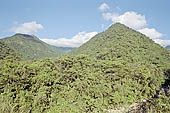
|
Manu NP
|
Above 1,500 masl there is an undulating topography that covers much of the park with relatively small hills. Between the hills alluvial plains are found along the rivers where sediments may be deposited on a seasonal basis. There are orchids, ferns, bromeliacae, giant begonias, butterflies and hummingbirds in a thick vegetation of palm and bamboo forests with crystalline waterfalls and strong currents, in a world of moss that covers everything indiscriminately. It is the home of the tunqui bird, the ucuman (Andean bear), the quetzal and countless monkeys.
Leaving the cloudy heights, one enters a flat land of clear rivers and abundant fruit, place of the colonist and forest clearer, the place where ancient Andeans discovered and cultivated coca. In this area the forest has been cleared somewhere to be replaced by tea, coffee and coca plantations.
Manu NP |
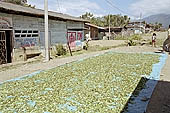
|
From now on the rivers slow down considerably. They wind slowly, leaving behind soft beaches of fine sand carried down from the Andes. The lower Manu River, down to its confluence with the Rio Alto Madre De Dios, over long periods of time has wandered over the plain leaving a number of ox-bow lakes in the flood plains. This is the Amazonian plain.
The forest is intact, trees stand 60 meters high with colossal vines hanging from them with the highest-density of bird life per square km.
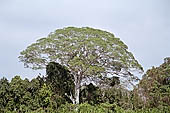
|
Manu NP
|
The trees are inhabited by birds ranging from powerful monkey-eating eagles up to one meter tall to tiny hummingbirds barely larger than insects. Special birds such as the Amazonian Umbrella bird, and Blue headed and Military Macaws can be found. The beaches are packed with nesting birds in the dry season; Large-billed terns scream at passing boats and Orinoco Geese watch warily from the shore. Only strange calls betray their presence until a mixed flock comes through, containing an astonishing 70-plus species; or a brightly colored group of Rock Parakeets dashes out of a fruiting tree. One can also spot flocks of colourful macaws, toucans, herons, wild turkeys, partridges and much more.
This forest has produced the highest day-list ever recorded on earth, and it holds such little-seen gems as Black-faced Cotinga and Rufous-fronted Ant-thrush.
Manu NP |
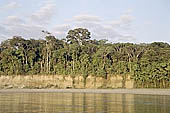
|
On top of all of that there is also a macaw lick that is the easiest to be visited in neotropical forests by tourists one of the world's great wildlife spectacles: hundreds of brightly colored macaws and other parrots congregate to eat the clay. In addition to serving as a community centre, the clay licks provide the macaw with essential minerals used to neutralize toxins of seeds and leaves that the macaw eats.
This is a territory filled with beautiful animals of prey, like jaguars and caymans. There are also tapirs anteaters, armadillos and sloths.
Only 300-500 natives live in the park, found throughout the area with the exception of the highlands and upper parts of the Manu River. They are of at least four different native groups: the Machiguenga (or Yora), the Mascho-Piro, the Yaminahua and the Amahuaca. The forest indians are nomadic, mostly subsistent on some form of root crop agriculture on alluvial soils along riverbanks and lakes, on hunting along watercourses and inside the forest, on fishing and on the collection of turtle eggs. Shifting cultivation is the basic agricultural practice. In this system, a patch of primary forest or an abandoned field is cleared, burned and used during the first, second and sometimes third year for cultivation. The field is then abandoned for at least five years and a new one is opened up. As it is easier to clear secondary growth on abandoned fields than to clear the primary forest, the indians prefer to re-use old fields. These peoples are considered part of the park's natural system, and are left to use the park as they please while their lifestyle does not threaten the park's objectives.
Traditional use of medicinal plants has remained quite important, traditional herbal medicinal knowledge of indigenous and tribal peoples is an important source for guiding pharmacological research. Yet native people have rarely been compensated for the contributions they have made: the rights of native peoples over their own resources and territories is rarely taken into account.
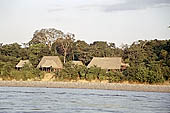
|
Manu NP
|
|
Related Pages
††-
††-
††-
††-
††-
††-
††-
††-
|
|
|
 |
|
|



